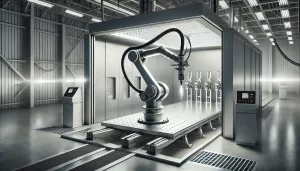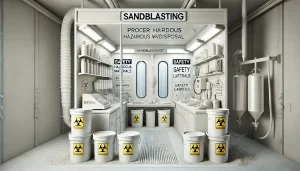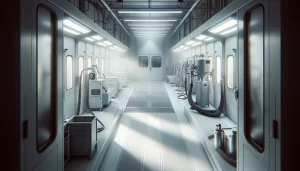Powder coating is a widely-used method for providing durable and attractive finishes to a variety of products, ranging from automotive parts to industrial equipment. The efficiency and quality of this process depend heavily on the proper functioning of powder coating ovens. However, even the best-maintained ovens can experience issues that impact coating results. Understanding common problems and knowing how to address them is essential for maintaining production quality and preventing costly downtime.
Uneven Curing
One of the most common issues in powder coating is uneven curing. This occurs when parts of the coating appear dull or inconsistent compared to the rest of the surface, indicating that some areas did not receive sufficient heat or time in the oven. The result is a finish that lacks durability and may not adhere properly to the substrate.
How to Fix It
Begin by checking the oven’s temperature distribution. Uneven curing is often due to hot or cold spots within the oven. Ensure that your temperature sensors and thermocouples are calibrated correctly, as faulty sensors can mislead operators into thinking the oven is operating at the correct temperature. Additionally, verify that parts are not overcrowded inside the oven. Adequate spacing is necessary for proper heat circulation around each piece. Adjusting the placement of parts or upgrading the oven’s airflow system can also help resolve this issue.
Inconsistent Color or Finish
Inconsistent color or finish is another common issue that can arise from improper oven settings. Sometimes, a part’s color may look slightly different after curing, or the finish may appear uneven, streaky, or blotchy. This problem is often the result of temperature variations or inconsistent powder application, which can be exacerbated by incorrect oven settings.
How to Fix It
First, confirm that the oven’s temperature is within the recommended range for the specific powder being used. Each powder has a defined curing temperature and duration, and deviating from these parameters can result in color shifts or finish variations. Double-check the settings on your oven and compare them to the powder manufacturer’s specifications. If the problem persists, inspect your powder application process to ensure even coating thickness. Addressing these factors should help achieve a consistent and uniform finish.
Blistering or Bubbling
Blistering or bubbling on the coated surface is often caused by contaminants trapped beneath the powder coat layer. This issue can also occur when moisture or oils are present on the substrate, and they expand during the curing process, causing the coating to lift or form bubbles.
How to Fix It
Proper surface preparation is critical to preventing blistering. Before applying powder, make sure the surface is completely clean and free from moisture, oil, or any other contaminants. Use an appropriate cleaning method such as sandblasting, chemical treatment, or a degreaser to prepare the substrate. Additionally, ensure that your oven is not overheating. Excessive temperatures can cause gasses to form and lead to bubbling. Use a temperature probe to verify the actual heat levels in different parts of the oven and adjust the settings accordingly.
Powder Clumping or Fines
Another common issue encountered in powder coating ovens is powder clumping or the presence of fines (tiny, dust-like particles). This problem typically arises due to poor storage conditions, high humidity, or contaminated powder. When the powder is not in optimal condition, it can lead to irregularities in the coating and an uneven surface.
How to Fix It
Store your powder in a controlled environment with stable humidity levels and avoid exposing it to moisture. Clumping is a sign that the powder has absorbed too much moisture, making it unusable for coating. Sifting the powder to remove clumps and fines can sometimes salvage the batch, but if the issue persists, it is best to replace the powder altogether. Regularly inspect and clean the hopper, as accumulated fines can affect the quality of subsequent batches.
Orange Peel Effect
The orange peel effect is a textured finish that resembles the surface of an orange peel, making the coating look uneven and unprofessional. This issue can occur due to a variety of reasons, such as incorrect oven temperature, poor powder flow, or uneven powder application.
How to Fix It
To address the orange peel effect, start by examining the oven’s temperature and curing time. Overheating or underheating can cause the powder to flow poorly, leading to this textured appearance. Also, check the powder’s shelf life and storage conditions, as old or moisture-affected powder can behave unpredictably during curing. Adjust the gun settings to ensure an even application and maintain the proper distance between the spray gun and the substrate. Regularly cleaning the spray gun can also prevent irregular powder flow.
Peeling or Poor Adhesion
Peeling or poor adhesion is a frustrating issue that often results in an immediate need for rework. This problem occurs when the powder coating fails to bond adequately with the surface, usually due to poor surface preparation or insufficient curing time.
How to Fix It
Focus on proper surface preparation. Make sure the part is clean, dry, and free from oils or other contaminants before applying the powder. Use a pre-treatment process such as sandblasting or chemical etching to create a surface profile that promotes adhesion. If surface prep is not the issue, revisit your curing process. Make sure the parts are reaching the target temperature for the recommended amount of time. Using a data logger can help verify the time and temperature profile of your oven.
Parts Warping or Distortion
Warping or distortion occurs when metal parts become deformed during the curing process. This issue is typically associated with excessive heat or prolonged curing times. Thin or complex-shaped parts are more prone to warping, as they cannot withstand extreme temperatures as well as thicker parts.
How to Fix It
Carefully monitor the oven temperature and reduce the curing time if necessary. Consider using an oven designed for low-temperature curing, which can achieve similar results without exposing parts to excessive heat. If warping continues to be an issue, experiment with different racking methods to provide better support and minimize stress on the parts during curing.
Powder Burn-Off
Powder burn-off occurs when the powder coating is exposed to high temperatures for too long, resulting in a charred, brittle, or discolored surface. This problem often happens if the oven’s temperature is not controlled properly or if the parts are left in the oven longer than necessary.
How to Fix It
Always set the oven temperature and duration according to the powder manufacturer’s guidelines. Consider using a timer and an automated shut-off system to prevent overheating. Regular maintenance and calibration of your oven’s temperature control systems are also essential to avoid this issue.
Our Expert Powder Coating Services
At our company, we take pride in offering expert powder coating services tailored to meet the specific needs of our clients. With years of experience in the industry, we understand that the quality of the finish is essential to both appearance and durability. Our state-of-the-art powder coating ovens ensure precise and consistent curing, delivering a smooth, tough, and long-lasting finish on every project. Whether you need powder coating for automotive parts, industrial equipment, or custom applications, our skilled technicians are committed to providing superior results every time.




